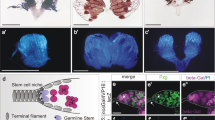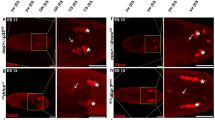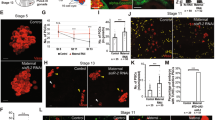Abstract
Germ cells are the only cells that transmit genetic information to the next generation, and they therefore must be prevented from differentiating inappropriately into somatic cells1. A common mechanism by which germline progenitors are protected from differentiation-inducing signals is a transient and global repression of RNA polymerase II (RNAPII)-dependent transcription1. In both Drosophila and Caenorhabditis elegans embryos, the repression of messenger RNA transcription during germ cell specification correlates with an absence of phosphorylation of Ser 2 residues in the carboxy-terminal domain of RNAPII (hereafter called CTD)2, a critical modification for transcriptional elongation3. Here we show that, in Drosophila embryos, a small protein encoded by polar granule component (pgc) is essential for repressing CTD Ser 2 phosphorylation in newly formed pole cells, the germline progenitors. Ectopic Pgc expression in somatic cells is sufficient to repress CTD Ser 2 phosphorylation. Furthermore, Pgc interacts, physically and genetically, with positive transcription elongation factor b (P-TEFb), the CTD Ser 2 kinase complex, and prevents its recruitment to transcription sites. These results indicate that Pgc is a cell-type-specific P-TEFb inhibitor that has a fundamental role in Drosophila germ cell specification. In C. elegans embryos, PIE-1 protein segregates to germline blastomeres, and is thought to repress mRNA transcription through interaction with P-TEFb4,5,6,7. Thus, inhibition of P-TEFb is probably a common mechanism during germ cell specification in the disparate organisms C. elegans and Drosophila.
This is a preview of subscription content, access via your institution
Access options
Subscribe to this journal
Receive 51 print issues and online access
$199.00 per year
only $3.90 per issue
Buy this article
- Purchase on Springer Link
- Instant access to full article PDF
Prices may be subject to local taxes which are calculated during checkout




Similar content being viewed by others
References
Seydoux, G. & Braun, R. E. Pathway to totipotency: lessons from germ cells. Cell 127, 891–904 (2006)
Seydoux, G. & Dunn, M. A. Transcriptionally repressed germ cells lack a subpopulation of phosphorylated RNA polymerase II in early embryos of Caenorhabditis elegans and Drosophila melanogaster . Development 124, 2191–2201 (1997)
Saunders, A., Core, L. J. & Lis, J. T. Breaking barriers to transcription elongation. Nature Rev. Mol. Cell Biol. 7, 557–567 (2006)
Seydoux, G. et al. Repression of gene expression in the embryonic germ lineage of C. elegans . Nature 382, 713–716 (1996)
Mello, C. C. et al. The PIE-1 protein and germline specification in C. elegans embryos. Nature 382, 710–712 (1996)
Batchelder, C. et al. Transcriptional repression by the Caenorhabditis elegans germ-line protein PIE-1. Genes Dev. 13, 202–212 (1999)
Zhang, F., Barboric, M., Blackwell, T. K. & Peterlin, B. M. A model of repression: CTD analogs and PIE-1 inhibit transcriptional elongation by P-TEFb. Genes Dev. 17, 748–758 (2003)
Nakamura, A., Amikura, R., Mukai, M., Kobayashi, S. & Lasko, P. F. Requirement for a noncoding RNA in Drosophila polar granules for germ cell establishment. Science 274, 2075–2079 (1996)
Martinho, R. G., Kunwar, P. S., Casanova, J. & Lehmann, R. A noncoding RNA is required for the repression of RNApolII-dependent transcription in primordial germ cells. Curr. Biol. 14, 159–165 (2004)
Deshpande, G., Calhoun, G. & Schedl, P. Overlapping mechanisms function to establish transcriptional quiescence in the embryonic Drosophila germline. Development 131, 1247–1257 (2004)
Shim, E. Y., Walker, A. K., Shi, Y. & Blackwell, T. K. CDK-9/cyclin T (P-TEFb) is required in two postinitiation pathways for transcription in the C. elegans embryo. Genes Dev. 16, 2135–2146 (2002)
Ni, Z., Schwartz, B. E., Werner, J., Suarez, J.-R. & Lis, J. T. Coordination of transcription, RNA processing, and surveillance by P-TEFb kinase on heat shock genes. Mol. Cell 13, 55–65 (2004)
Peterlin, B. M. & Price, D. H. Controlling the elongation phase of transcription with P-TEFb. Mol. Cell 23, 297–305 (2006)
Zhu, Y. et al. Transcription elongation factor P-TEFb is required for HIV-1 Tat transactivation in vitro . Genes Dev. 11, 2622–2632 (1997)
Peng, J., Marshall, N. F. & Price, D. H. Identification of a cyclin subunit required for the function of Drosophila P-TEFb. J. Biol. Chem. 273, 13855–13860 (1998)
Lis, J. T., Mason, P., Peng, J., Price, D. H. & Werner, J. P-TEFb kinase recruitment and function at heat shock loci. Genes Dev. 14, 792–803 (2000)
Eissenberg, J. C., Shilatifard, A., Dorokhov, N. & Michener, D. E. Cdk9 is an essential kinase in Drosophila that is required for heat shock gene expression, histone methylation and elongation factor recruitment. Mol. Genet. Genomics 277, 101–114 (2007)
Boehm, A. K., Saunders, A., Werner, J. & Lis, J. T. Transcription factor and polymerase recruitment, modification, and movement on dhsp70 in vivo in the minutes following heat shock. Mol. Cell. Biol. 23, 7628–7637 (2003)
Wei, P., Garber, M. E., Fang, S. M., Fischer, W. H. & Jones, K. A. A novel CDK9-associated C-type cyclin interacts directly with HIV-1 Tat and mediates its high-affinity, loop-specific binding to TAR RNA. Cell 92, 451–462 (1998)
Barboric, M. & Peterlin, B. M. A new paradigm in eukaryotic biology: HIV Tat and the control of transcriptional elongation. PLoS Biol. 3, e76 (2005)
Nguyen, V. T., Kiss, T., Michels, A. A. & Bensaude, O. 7SK small nuclear RNA binds to and inhibits the activity of CDK9/cyclin T complexes. Nature 414, 322–325 (2001)
Yang, Z., Zhu, Q., Luo, K. & Zhou, Q. The 7SK small nuclear RNA inhibits the CDK9/cyclin T1 kinase to control transcription. Nature 414, 317–322 (2001)
Michels, A. A. et al. MAQ1 and 7SK RNA interact with CDK9/Cyclin T complexes in a transcription-dependent manner. Mol. Cell. Biol. 23, 4859–4869 (2003)
Yik, J. H. N. et al. Inhibition of P-TEFb (CDK9/Cyclin T) kinase and RNA polymerase II transcription by the coordinate action of HEXIM1 and 7SK RNA. Mol. Cell 12, 971–982 (2003)
Extavour, C. G. & Akam, M. Mechanisms of germ cell specification across the metazoans: epigenesis and preformation. Development 130, 5869–5884 (2003)
Saitou, M., Barton, S. C. & Surani, M. A. A molecular programme for the specification of germ cell fate in mice. Nature 418, 293–300 (2002)
Ohinata, Y. et al. Blimp1 is a critical determinant of the germ cell lineage in mice. Nature 436, 207–213 (2005)
Seki, Y. et al. Cellular dynamics associated with the genome-wide epigenetic reprogramming in migrating primordial germ cells in mice. Development 134, 2627–2638 (2007)
Macdonald, P. M. & Struhl, G. Cis-acting sequences responsible for anterior localization of bicoid mRNA in Drosophila embryos. Nature 336, 595–598 (1988)
Spradling, A. C. & Rubin, G. M. Transposition of cloned P elements into Drosophila germ line chromosomes. Science 218, 341–347 (1982)
Larochelle, S., Pandur, J., Fisher, R. P., Salz, H. K. & Suter, B. Cdk7 is essential for mitosis and for in vivo Cdk-activating kinase activity. Genes Dev. 12, 370–381 (1998)
Alekseyenko, A. A., Larschan, E., Lai, W. R., Park, P. J. & Kuroda, M. I. High-resolution ChIP-chip analysis reveals that the Drosophila MSL complex selectively identifies active genes on the male X chromosome. Genes Dev. 20, 848–857 (2006)
Agata, Y. et al. Histone acetylation determines the developmentally regulated accessibility for T cell receptor γ gene recombination. J. Exp. Med. 193, 873–880 (2001)
Acknowledgements
We thank K. Zinn for the lambda phage genomic clone containing the gp150 region, P. Rørth and E. R. Gavis for plasmids, J. T. Lis, D. H. Price and S. Larochelle for antibodies, the Berkeley Drosophila Genome Project and the Bloomington Drosophila stock center for fly stocks, and J. Nakayama, M. Ukai-Tadenuma and H. R. Ueda for technical advice on ChIP analysis. This work was supported in part by a Grant-in-Aid from the Ministry of Education, Culture, Sports, Science and Technology, and Japan Society of the Promotion of Science, Japan and the RIKEN President Discretionary Fund (to A.N.), and by grants from CIHR and NICHD (to P.L.).
Author Contributions K.H.-N., P. L. and A.N. conceived and designed the experiments. K.H.-N., H.S.-N., A T. and A. N. performed the experiments and generated all the figures. P.L. and A.N. wrote the paper.
Author information
Authors and Affiliations
Corresponding author
Supplementary information
Supplementary Information
The file contains Supplementary Figures 1-10 with Legends, Supplementary Table 1, Supplementary Discussion and additional references. (PDF 3679 kb)
Rights and permissions
About this article
Cite this article
Hanyu-Nakamura, K., Sonobe-Nojima, H., Tanigawa, A. et al. Drosophila Pgc protein inhibits P-TEFb recruitment to chromatin in primordial germ cells. Nature 451, 730–733 (2008). https://doi.org/10.1038/nature06498
Received:
Accepted:
Published:
Issue Date:
DOI: https://doi.org/10.1038/nature06498
This article is cited by
-
Tissue-specific RNA Polymerase II promoter-proximal pause release and burst kinetics in a Drosophila embryonic patterning network
Genome Biology (2024)
-
A hidden translatome in tumors—the coding lncRNAs
Science China Life Sciences (2023)
-
Germline stem cells in human
Signal Transduction and Targeted Therapy (2022)
-
Absence of X-chromosome dosage compensation in the primordial germ cells of Drosophila embryos
Scientific Reports (2021)
-
Pegasus, a small extracellular peptide enhancing short-range diffusion of Wingless
Nature Communications (2021)
Comments
By submitting a comment you agree to abide by our Terms and Community Guidelines. If you find something abusive or that does not comply with our terms or guidelines please flag it as inappropriate.



